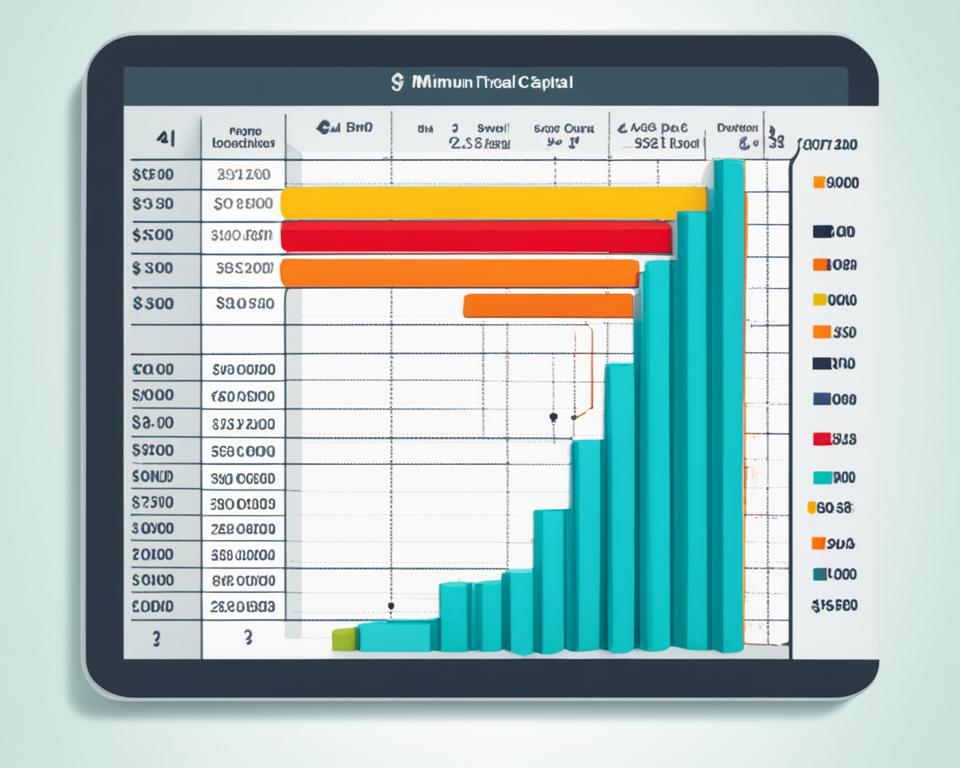Day trading can be an exciting and potentially profitable venture, but it’s important to understand the financial requirements that come with it. If you’re considering becoming a day trader, you may have come across the $25,000 minimum account size requirement. But why exactly do you need this amount to day trade? Let’s explore the rules and regulations surrounding day trading capital requirements.
In 2001, the Financial Industry Regulatory Authority (FINRA) and the Securities and Exchange Commission (SEC) implemented the pattern day trader (PDT) rule to protect market participants. This rule classifies individuals as pattern day traders if they make more than four day trades in a five-day period from a margin account, and these trades make up more than 6% of their total margin trading activity.
Pattern day traders are then required to maintain a minimum account balance of $25,000 to continue day trading. This rule is in place to ensure the financial stability of day traders and minimize risks. By having a sufficient account balance, day traders have the necessary funds to cover potential losses and maintain the stability of the market.
Key Takeaways:
- Day trading requires a minimum account balance of $25,000 due to the pattern day trader (PDT) rule.
- The PDT rule applies to individuals who make more than four day trades in a five-day period.
- Maintaining the $25,000 account balance ensures day traders have sufficient funds to cover potential losses.
- The rule aims to protect market participants and maintain the stability of the market.
- Understanding the financial requirements of day trading is essential for aspiring day traders.
Table of Contents
What Does the IRS Consider a Day Trader?
Understanding how the Internal Revenue Service (IRS) classifies day traders is crucial for tax purposes. The IRS has specific criteria that individuals must meet to be considered day traders.
- Seeking to profit from daily market movements: Day traders aim to capitalize on short-term price fluctuations in securities. It involves buying and selling securities within the same trading day.
- Engaging in substantial day trading activity: To be classified as a day trader, individuals must actively participate in day trading activities, executing frequent trades.
- Carrying out this activity with continuity and regularity: Day trading should not be an occasional hobby but rather a consistent and regular pursuit. This means dedicating a significant amount of time and effort to day trading activities.
The IRS takes various factors into account when determining an individual’s day trader classification. These factors include the length of time securities are held, the frequency and dollar amounts of trades, the extent to which day trading is pursued for income, and the time devoted to day trading.
To be classified as a day trader for tax purposes, your day trading activities must meet the criteria of a business or serve as your primary source of income. It’s important to maintain accurate records of your trades and consult with a tax professional to ensure compliance with IRS guidelines.
Day Trading Income and Tax Implications
Earnings from day trading are subject to specific tax rules. Day trading income is considered ordinary income and is typically taxed at the individual’s applicable income tax rate. It’s important to report all day trading profits and losses accurately on your tax returns.
Day traders can deduct certain business expenses related to their trading activities. These may include technology expenses, trading software, market data subscriptions, and educational materials. It’s advisable to consult with a tax professional who specializes in day trading to ensure you maximize deductions while staying within the IRS guidelines.
Properly understanding the IRS classification of day trader status and the related tax implications allows traders to meet their tax obligations while optimizing their trading strategies.
Why Do You Need $25,000 To Day Trade?
The main reason for the $25,000 requirement to day trade is the pattern day trader (PDT) rule. According to this rule, a pattern day trader is a trader who executes four or more day trades within five business days using the same brokerage account. Once a trader makes their fourth day trade, their account is flagged as a PDT, and they must maintain at least $25,000 in their margin account to continue day trading. If the account balance falls below $25,000, the trader is prohibited from making further day trades until the balance is restored. This requirement is in place to ensure that day traders have sufficient funds to cover potential losses and maintain the stability of the market.
Can I Day Trade With Less Than $25,000?
Day trading with a balance of less than $25,000 is indeed possible, but it does come with certain limitations. When operating with less capital, traders are restricted to making only three day trades within a five-day period. This limitation can hinder their ability to take full advantage of short-term trading opportunities and potentially limit their profits.
However, traders with lower account balances can still find success in day trading by carefully managing their trades and implementing alternative strategies. One such strategy is swing trading, where positions are held for longer than one day, allowing traders to capitalize on medium-term market movements. This approach can be more suitable for traders with smaller account balances as it reduces the need for frequent day trades, thus mitigating the impact of the PDT rule.
Furthermore, there are alternative markets, such as Forex, Futures, or Options, where traders can engage in day trading with smaller account balances. These markets often have lower capital requirements and different regulations, allowing traders with limited funds to participate in day trading while adhering to their account balance limitations.
While day trading with less than $25,000 may have limitations, it’s important for traders to focus on effective risk management and developing strategies that align with their account balance. By being mindful of these limitations and exploring alternative trading approaches, traders can still pursue day trading with smaller account balances.
How To Get Around Pattern Day Trading Rules
For traders who want to bypass pattern day trading rules, there are several strategies to consider:
- Making only three day trades in a five-day period: By limiting your day trades to three within a five-day timeframe, you can avoid being classified as a pattern day trader. This strategy allows you to engage in day trading while adhering to the regulatory requirements.
- Opening day trading accounts with different brokers: Another approach is to open multiple day trading accounts with different brokers. By spreading your trades across different accounts, you can avoid exceeding the pattern day trading limits imposed on individual brokerage accounts.
- Day trading in markets outside the United States: Trading in markets outside the United States is an alternative way to bypass pattern day trading rules. The rules and regulations may differ, allowing you to take advantage of different trading opportunities and flexibility.
- Using swing trading strategies with longer holding periods: Instead of day trading, you can opt for swing trading strategies that involve holding positions for longer periods, typically from a few days to weeks. This approach allows you to avoid the frequency limitations of day trading and opens up additional opportunities.
- Working with day trader firms: Collaborating with day trader firms can provide alternative opportunities for trading without being subject to pattern day trading rules. These firms typically have their own rules and may offer more flexibility for day trading activities.
- Exploring different markets like Forex, Futures, or Options: Lastly, diversifying into alternative markets such as Forex, Futures, or Options can provide opportunities for day trading while circumventing the restrictions imposed on stock trading. These markets often have different regulations and may offer more flexibility for day traders.
While these strategies offer some flexibility in bypassing pattern day trading rules, it is essential to note that adhering to the rules and maintaining a minimum balance of $25,000 in a margin account offers the most benefits and potential profitability in day trading.
Conclusion
In summary, meeting the day trading requirements, such as the $25,000 minimum account balance, is crucial for successful day trading. These requirements are enforced by the pattern day trader (PDT) rule, which aims to maintain market stability and protect traders from excessive risks. While it may be possible to engage in day trading with lower account balances or bypass PDT rules, it’s important to understand the limitations and potential consequences.
By following the rules and regulations, day traders can maximize the opportunities presented by short-term trading and minimize the risks involved. Maintaining the minimum account balance allows traders to take advantage of the flexibility provided by day trading and seize profitable opportunities in the market. It also ensures that traders have sufficient funds to cover potential losses and maintain a stable trading account.
However, it’s essential to remember that day trading, like any form of trading, involves a balance of risks and opportunities. It’s crucial for traders to weigh these factors carefully and make informed decisions based on their risk tolerance and trading strategies. By doing so, day traders can strive for success in the dynamic world of day trading while adhering to the necessary requirements and regulations.


